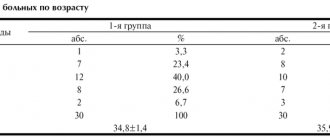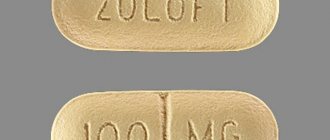Pharmacological properties of the drug Buspirone hexal
Anxiolytic drug, eliminates mental and autonomic symptoms of fear. The mechanism of action has not been fully established, but it is known that buspirone has a different mechanism of action than benzodiazepines and other anxiolytic drugs. Shows similarity to serotonin 5HT1A receptors and moderate similarity to D2 in the brain. In a series of preclinical studies on experimental models, the presence of properties typical of anxiolytics and antidepressants in buspirone was revealed. Does not exhibit anticonvulsant or muscle relaxant effects, and is not addictive. After discontinuation of use, buspirone does not cause withdrawal symptoms or rapid relapse of anxiety symptoms. After oral administration, buspirone is quickly and completely absorbed from the gastrointestinal tract, but since it is extensively metabolized (phase II), its systemic availability is 4%. The maximum concentration of the drug in the blood plasma is achieved after 60–80 minutes. Within the recommended doses, buspirone exhibits linear pharmacokinetics. The half-life from blood plasma is 2–3 hours. More than 95% of the active substance is bound to blood plasma proteins. With continuous use, the pharmacological parameters of the drug do not change (there is no accumulation); their deviations have not been detected in healthy elderly people. The main pharmacologically active metabolite of buspirone is 1-[2-pyrimidinyl]-piperazine (1-PP). After oral administration of buspirone, the maximum concentration of the drug metabolite in the blood plasma is also achieved after 60–90 minutes. Nevertheless, the value of this concentration is 7–8 times higher than that for buspirone. The plasma half-life of 1-PP increases by approximately 6 hours compared to buspirone. After administration of repeated therapeutic doses of buspirone, a 13-fold increase in exposure to 1-PP was found compared to a similar compound.
Pharmacological properties of the drug Buspirone
Anxiolytic agent. Eliminates mental and vegetative symptoms of fear. The mechanism of action is not completely understood, but it is known that buspirone acts differently than benzodiazepines and other anxiolytic drugs. Shows pronounced affinity for serotonin 5HT1A receptors and moderate affinity for dopamine D2 receptors in the brain. Does not have anticonvulsant or muscle relaxant effects and is not addictive. There is no withdrawal symptoms after stopping the use of buspirone.
Use of the drug Buspirone hexal
The dosage regimen is selected individually and depends on the patient’s health status before treatment. For patients over 18 years of age, the following dosage regimen is recommended: At the beginning of therapy, 5 mg of buspirone hydrochloride is prescribed 3 times a day. To achieve the maximum therapeutic effect, the daily dose is increased by 5 mg at intervals of 2–3 days. The optimal daily dose is usually 20–30 mg of buspirone hydrochloride, divided into several doses. The maximum single dose should not exceed 30 mg, daily - 60 mg of buspirone hydrochloride. The tablets should be taken without chewing, with a small amount of liquid, after meals or regardless of meals. Duration of treatment - no more than 4 months.
Special instructions for the use of Buspirone
Buspirone is not an antipsychotic drug. Does not prevent the development of withdrawal symptoms caused by long-term use of benzodiazepines; Before starting treatment with buspirone, the use of anxiolytic drugs should be gradually discontinued. Buspirone affects the psychophysical abilities of the body, reducing concentration and reaction speed, especially when drinking alcohol or taking drugs that depress the central nervous system. Buspirone should not be prescribed during pregnancy unless there are absolute indications for its use. During treatment with buspirone, breastfeeding should be interrupted.
Side effects of the drug Buspirone Hexal
The most common are drowsiness, nausea, headache, nervousness, dizziness and agitation (irritability). In addition, in very rare cases, the following side effects have been identified: Respiratory system: excessive tachypnea. Visual organs: blurred vision, itching in the eyes, conjunctivitis, feeling of pressure on the eyes. Blood: eosinophilia, leukopenia, thrombocytopenia. Genitourinary system: dysmenorrhea, impaired urination, decreased or increased libido, amenorrhea, enuresis, impaired ejaculation. Ear, throat, nose: tinnitus, pharyngitis, nasal congestion, nosebleeds. Skin: eczema, swelling, urticaria, hyperemia, diathesis with hematoma, alopecia, allergic reactions, acne. Cardiovascular system: nonspecific pectoralgia, loss of consciousness, hypotension or hypertension, cerebrovascular accident, heart failure, cardiomyopathy, bradycardia. Endocrine system: gynecomastia, dysfunction of the thyroid gland. Liver: increased liver test values. Muscular system: myalgia, myospasm, arthralgia, myasthenia gravis. Nervous system: paresthesia, incoordination, tremors, disturbing dreams, hostility, confusion, involuntary movements, decreased reaction time, psychosis, pathologically increased perception of ordinary sounds, hyperkinesia, loss of interest in the environment, fatigue, impaired association, suicidal thoughts, abrupt change moods, claustrophobia, stupor, slurred speech, psychosis. Gastrointestinal tract: flatulence, lack of appetite, irritation of the colon.
Special instructions for the use of Buspirone Hexal
Not all anxiety conditions require treatment, as they may also be complications of physical or mental illness that require treatment for the underlying condition. Buspirone is not intended to treat withdrawal symptoms associated with benzodiazepine use; for this reason, before starting treatment with buspirone, you should gradually stop using anxiolytic drugs and only then proceed to therapy with Buspirone HEXAL. Pregnancy and breastfeeding Since there is no experience with the use of buspirone during pregnancy, the drug can be prescribed only with an established diagnosis and absolute indications for its use. In experiments on animals, the teratogenic effect of the drug was not revealed. Breastfeeding should be discontinued during treatment. Effects on driving vehicles or other complex machinery Buspirone may affect alertness and concentration, especially at the beginning of treatment. This fact must be taken into account by patients who are engaged in potentially hazardous activities that require increased attention and speed of psychomotor reactions.
Buspirone (pitomin) is a non-benzodiazepine anxiolytic that is a derivative of azapirone. Azapyrones are a class of drugs with high affinity for serotonin 5-HT1A receptors located on the body and in the endings of serotonergic neurons, as well as in the dendrites of postsynaptic neurons with which the serotonergic endings contact. The anti-anxiety effect of buspirone is not associated with an effect on GABA-benzodiazepine receptors. However, in terms of anxiolytic activity, buspirone is comparable to benzodiazepines such as diazepam, lorazepam or alprazolam, but unlike them, it does not cause drug dependence, cognitive and psychomotor impairment, or pronounced sedative and muscle relaxant effects [1].
Mechanism of action of buspirone
The mechanism of the anxiolytic action of buspirone, which determines its characteristics, is explained mainly by its effect on serotonin receptors. Buspirone has a high affinity for presynaptic serotonin (5-HT1A) receptors, of which it is an agonist, as well as for postsynaptic serotonin receptors, for which it can be considered a partial agonist [1].
Partial agonists are ligands that bind to receptors, but are able to cause only partial activation. If a partial agonist interacts with free receptors, it causes incomplete (50%) activation of the cell. If a partial agonist acts on a tissue whose receptors are already activated by a full agonist, then due to the displacement of the latter from communication with the receptor, the cell response decreases and, therefore, it has a blocking effect.
Thus, due to its receptor action, buspirone reduces the synthesis and release of serotonin, reduces the activity of serotonergic neurons of the raphe nuclei (“serotonin stabilizer”). Buspirone is also able to interact with postsynaptic 5-HT2 receptors, but has low affinity for them. Being a partial agonist, due to its postsynaptic action it can theoretically reduce serotonergic activity and cause an anxiolytic effect, and due to its action on somatodendritic serotonin presynaptic autoreceptors, it can theoretically enhance serotonergic activity and cause an antidepressant effect.
To a lesser extent, the drug selectively blocks pre- and postsynaptic D2-dopamine receptors. Moreover, it was originally developed as an antipsychotic drug, but it was later discovered that it has low affinity for dopamine receptors, and its presynaptic action predominates over the postsynaptic one, which prevents the neuroleptic effect.
Experimental studies have indicated a decrease in serotonin turnover with low doses of buspirone, reflecting stimulation of presynaptic autoreceptors. However, repeated administration of buspirone reduced the response of somatodendritic 5-HT1A receptors, since the decrease in 5-HT metabolism was less pronounced.
Buspirone may act as a partial agonist at postsynaptic serotonin 5-HT1A receptors in the hippocampus and prefrontal cortex, as well as at presynaptic autoreceptors on the cell bodies of serotonergic neurons. Since the effect of azapirones develops over several days, it does not appear to be due to their direct effect on the receptors. Animal studies suggest that the anxiolytic effect of these drugs is related to their action on presynaptic receptors, and the antidepressant effect is related to their action on postsynaptic receptors.
A decrease in serotonin turnover also occurs in the striatum, which may be accompanied by an inhibitory effect on dopaminergic transmission. This effect is reflected in the fact that coadministration of buspirone may attenuate apomorphine sensitization. Thus, buspirone at a relatively low dose may counteract the side effects of apomorphine. However, administration of buspirone at a higher dose caused sensitization of motor behavior [2].
This effect may be explained by blockade of presynaptic dopamine autoreceptors. The experimental administration of a relatively high dose of buspirone caused a sharp increase in the synthesis and metabolism of dopamine in the striatum.
The experiment showed that the administration of buspirone in brain dialysate reduces the level of serotonin by 50%, but increases the level of dopamine by 100% and norepinephrine by 140%, which indicates a complex effect of buspirone on monoaminergic neuromediation [3].
However, in addition to the effect on autoreceptors, buspirone also has another point of application, since the administration of haloperidol, which blocks D1- and D2-postsynaptic mesolimbic and striatal receptors, did not block the dopaminomimetic effect of buspirone. It has been shown that the antagonistic effect of the drug on D2 receptors is 15 times weaker than the effect on 5-HT1A receptors. Buspirone blocks postsynaptic dopamine receptors relatively weakly, even at high doses. It binds with higher affinity to D3 and D4 receptors than to D2 receptors. The effect on presynaptic dopamine receptors is stronger than blockade of postsynaptic receptors. Only in extremely large doses are postsynaptic striatal D1 and D2 receptors blocked quite actively. However, weak postsynaptic dopaminergic antagonism weakens the presynaptic dopaminomimetic effect of the drug, avoiding stereotypy [2, 3].
Use of buspirone for generalized anxiety and other affective disorders
The greatest experience with the use of buspirone has been accumulated in generalized anxiety disorder (GAD). Clinical research over the past 30 years has been accompanied by constant improvement of the nosological structure of anxiety disorders. At the beginning of the 20th century, understanding of anxiety disorders was rather vague, but over time their place among other mental disorders was more clearly defined, partly under the influence of pharmacological research.
Symptoms of GAD are chronic and often observed in patients visiting general practitioners. Typically, such patients present vague somatic complaints of fatigue, muscle pain or tension, and sleep disturbances.
Buspirone is the first nonbenzodiazepine anxiolytic to be approved by the FDA for the treatment of GAD based on studies showing it to be as effective as benzodiazepines.
According to DSM-V criteria [4], GAD is characterized by:
A. Excessive anxiety and worry (anxious expectations), occurring most days for at least 6 months and manifesting itself in a variety of events or actions (for example, when performing professional duties or while studying at school).
B. Difficulty controlling anxiety.
B. The presence of at least 3 of the following symptoms most days for 6 months: motor restlessness or a feeling of restlessness; fast fatiguability; difficulty concentrating and distractibility; irritability; muscle tension; sleep disturbance.
D. Clinically significant distress or impairment in social, occupational and other activities caused by anxiety, restlessness or physical (psychomotor) symptoms.
D. These disorders that cannot be explained by the physiological effect of a psychoactive substance or a somatic disease.
E. These disorders that cannot be explained by another mental illness.
Buspirone has also been successfully used for the prophylactic treatment of migraine and alcoholism in individuals with comorbid anxiety disorders, as well as for the treatment of anxious depression, anxiety, and agitation in patients with traumatic brain injury [5, 6].
The direct antidepressant effect of buspirone, independent of its anxiolytic effect, has also been demonstrated. It may be due to the fact that the sensitivity of 5-HT1A autoreceptors is increased in depression, while the properties of postsynaptic 5-HT1A and 5-HT2A receptors do not change in untreated patients with depression.
Data on the effectiveness of buspirone in obsessive-compulsive disorder are contradictory, but some studies show a positive effect of the drug, especially when combined with other psychopharmacological drugs, primarily antidepressants. An open-label study showed that adding buspirone (at a dose of 30-90 mg/day) to selective serotonin reuptake inhibitors (SSRIs) increased the effectiveness of treatment of body dysmorphic disorder in almost half of patients, mainly in those who had partial response to serotonergic antidepressants [ 7, 8].
Buspirone can be considered as an alternative to antidepressants in the treatment of social phobia. The effect of buspirone on social phobia was demonstrated in a placebo-controlled study. When added to SSRIs, buspirone can correct some of their side effects. For example, it has been shown that at a dose of 15-60 mg/day it can reduce sexual dysfunction and bruxism [8].
Anti-aggressive effect of buspirone
Special mention should be made of the anti-aggressive effect of buspirone in cases of agitation and aggressive actions in patients with dementia, attention deficit hyperactivity disorder, and traumatic brain injury [8]. At the same time, the effect of buspirone at a dose of 15-60 mg/day was noted in relation to both verbal (60%) and physical (90%) aggression [9-12].
Effect of buspirone on cognitive function
Data on the effect of buspirone on cognitive functions are contradictory; some studies showed a moderate positive effect on regulatory functions, while others showed no obvious effect [13]. In any case, unlike benzodiazepines and sedatives, buspirone does not have a negative effect on cognitive function, which distinguishes it from other drugs used to correct anxiety disorders [14].
Use of buspirone for the treatment of dependence syndrome
Due to its dopaminergic action, buspirone can be used to treat addiction syndrome. This quality was originally discovered in relation to cocaine addiction. It has been experimentally shown that intramuscular administration of buspirone blocks D2 and D3 receptors, while when administered orally, buspirone more selectively blocks D3 receptors, occupying more than 80% of the receptors. Thus, higher doses may be required to treat addiction—2 to 3 times higher than to treat anxiety (up to a maximum of 60 mg). Previous studies indicate that these doses are safe and well tolerated [15]. Correction of withdrawal anxiety under the influence of buspirone can also contribute to the treatment of alcohol and tobacco addiction [16–18].
Use of buspirone for extrapyramidal disorders
Experimental and clinical studies suggest that buspirone may be effective in treating tardive dyskinesia. Tardive dyskinesia is characterized by involuntary movements involving the muscles of the head, limbs, or trunk. It usually occurs during long-term therapy with antipsychotics, often manifesting itself or intensifying after their withdrawal. Tardive dyskinesia is usually resistant to various treatments. Although the evidence base for buspirone for tardive dyskinesia is weak, it may be an alternative to other drugs (particularly dopaminergic drugs) with dangerous side effects. The mechanism of action of buspirone in tardive dyskinesia is unclear [19, 20].
Buspirone may also be effective in patients with Parkinson's disease suffering from dyskinesias during long-term levodopa therapy. The mechanism of action of the drug is not clear enough in this case either, but the therapeutic effect depends on the dose. In recent years, it has been shown using pathomorphological and imaging methods that the serotonergic system is involved in the pathological process in Parkinson's disease, in particular in the pathogenesis of a number of non-motor symptoms, as well as drug-induced dyskinesias. Because of this, drugs acting on the serotonergic system can be effective against dyskinesias and non-motor symptoms such as depression, chronic fatigue, and psychotic disorders [21].
It has already been mentioned that 5-HT1A receptor agonists regulate the striatal concentration of dopamine formed from exogenous levodopa, due to which buspirone can attenuate drug-induced dyskinesias (“peak dose”) in Parkinson’s disease.
A clinical study [22] showed that sequential use of the drug for 3 days (at a dose of 15-30 mg/day), but not a single dose of the drug at a dose of 10 and 20 mg, led to a 20% decrease in dyskinesias (without an increase in parkinsonism symptoms ). In another study, 3 weeks of buspirone 20 mg/day reduced the severity of drug-induced dyskinesias by 71% without any negative effect on parkinsonian symptoms. Thus, buspirone can be considered as a potentially effective strategy in the correction of drug-induced dyskinesias.
These clinical data were confirmed experimentally - at a dose of 2 mg/kg, buspirone weakened violent movements by 45% in mice with an experimental model of dopaminergic dyskinesia. Administration of buspirone to rats at a dose of 0.25-2.5 mg/kg 30 minutes before levodopa reduced dyskinesias and improved locomotor activity. In an experiment, buspirone reduced catalepsy in rats induced by 6-OHDA and haloperidol.
The effectiveness of buspirone has also been shown for dyskinesias that occur after transplantation of fetal midbrain tissue. It is assumed that transplantation dyskinesias are associated with serotonergic neuromediation [23]. Correction of dyskinesias is more effective with the administration of a high dose of 5-HT1A agonist, which more completely blocks the release of the transmitter. Dopaminergic reinnervation after transplantation causes persistent dyskinesias due to the uncontrolled release of dopamine caused by serotonin. The release of dopamine occurs with less intensity than with “peak dose” dyskinesia. Accordingly, the effect in this situation is more pronounced with systemic administration of lower doses of 5-HT1A agonists [22, 23].
Buspirone may be effective in hereditary spinocerebellar ataxias, which is explained by the pronounced serotonergic innervation of the cerebellum [24]. It is believed that this effect may also be associated with an effect on noradrenergic pathways. This assumption has been supported by several studies showing that buspirone reduces mild to moderate cerebellar ataxia by 37%. The positive effect of buspirone on the severity of ataxia was confirmed in a small placebo-controlled study [25, 26].
Practical aspects of the use of buspirone (spitomin)
The main indications for the use of buspirone (spitomin) registered in the Russian Federation are generalized anxiety disorder (GAD), panic disorder, autonomic dysfunction syndrome, alcohol withdrawal syndrome (as an auxiliary therapy), depressive disorders (as an auxiliary therapy, but not prescribed for monotherapy of depression ). The literature describes the use of buspirone for various anxiety conditions, tobacco withdrawal, depression, as well as autism, obsessive-compulsive and premenstrual syndromes (in which the drug acts as an adjuvant). The mechanism of action allows its use for the treatment of resistant depression (in combination with an antidepressant) [27].
The therapeutic (anxiolytic) effect develops gradually, manifests itself after 7-14 days and reaches a maximum after 4 weeks.
The goal of treatment for mood disorders may be to achieve complete remission or, at a minimum, a reduction in symptoms, and, if possible, to prevent possible relapses. For chronic anxiety disorders, long-term maintenance therapy with buspirone may be required for long-term symptom control.
An important advantage of buspirone is that, unlike such classical anxiolytics as benzodiazepines, it does not have a negative effect on psychomotor functions, does not cause tolerance, drug dependence and withdrawal symptoms, and does not potentiate the effect of alcohol. However, alcohol consumption should be avoided during treatment with buspirone [28].
The absence of a therapeutic effect within 6-8 weeks requires an increase in the dose, but in some cases indicates resistance to the drug. If there is no effect, the drug is usually replaced with another drug (benzodiazepine or antidepressant). If the effect is partial, an antidepressant, sedative or hypnotic (for insomnia) can be added to enhance its effect. Buspirone is especially often used in combination with an SSRI or a selective serotonin norepinephrine reuptake inhibitor (SNRI) [29].
Use in persons under 18 years of age is contraindicated, according to the instructions for buspirone in force in the Russian Federation. No efficacy studies have been conducted in children and adolescents aged 6 to 18 years for anxiety disorders. Pregnancy and breastfeeding are also contraindications, although there is no direct evidence of danger.
Buspirone is usually well tolerated. Side effects, if observed, usually occur early in the course of treatment and then disappear despite continued use of the drug. In some cases, a dose reduction is necessary. As a side effect, the drug can cause dizziness, headache, weakness, sleep disturbance, decreased attention, extrapyramidal disorders (very rare), confusion, nausea, dry mouth, diarrhea, vomiting, constipation, weight loss, weight gain, myalgia, muscle spasms, rash, sweating, paresthesia. In case of overdose, vomiting, dizziness, miosis, and depression of consciousness are possible. The drug is combined with caution with antipsychotics, cardiac glycosides, antihypertensive and antidiabetic drugs, and oral contraceptives. Interaction with MAO inhibitors can lead to serotonin syndrome or hypertensive crisis with more limited symptoms; therefore, the simultaneous use of buspirone and MAO inhibitors is contraindicated in the instructions for medical use.
In the Russian Federation, the drug is presented in the form of divisible tablets of 10 mg. The initial dose is 5 mg/day, if necessary, it is increased by 5 mg every 5 days. The average daily dose is 15 mg. The maximum single dose is 30 mg, the maximum daily dose is 60 mg. The daily dose is usually divided into 2-3 doses. The advantages of the drug include safety, absence of dependence and withdrawal syndrome, sexual dysfunction and weight gain. Moreover, buspirone is able to attenuate sexual dysfunction caused by generalized anxiety and serotonergic antidepressants [28, 30].
The peculiarities of the drug include the gradual onset of the full clinical effect (within 4 weeks), while benzodiazepines act more quickly.
Buspirone is metabolized primarily by the microsomal enzyme CYP450 3A4. T½ is approximately 2-3 hours. Particular caution should be observed when combined with CYP450 3A4 inhibitors (for example, diltiazem, verapamil, itraconazole, erythromycin), which can reduce the clearance of buspirone and increase its level in the blood. You should also avoid drinking large amounts of grapefruit and grapefruit juice at the same time. The dose of buspirone should also be reduced when using HIV protease inhibitors or ketoconazole. Inducers of CYP450 3A4 (eg carbamazepine and rifampicin), on the contrary, may increase the clearance of buspirone. Buspirone increases blood levels of nordiazepam, the active metabolite of diazepam, which can cause dizziness, headache, and nausea.
For renal and liver failure of mild to moderate severity, liver cirrhosis, heart failure, and in the elderly, the drug is prescribed in lower doses. When discontinuing the drug, a gradual dose reduction is usually not necessary. In case of severe renal and liver failure, uncontrolled epilepsy, glaucoma, myasthenia gravis, the drug is contraindicated.
Thus, buspirone, with its unique neurotransmitter effects, significantly expands treatment options for a wide range of mental and neurological disorders - from anxiety disorders to dyskinesia in Parkinson's disease and ataxia. The relative safety of the drug makes its use in clinical practice very promising.




